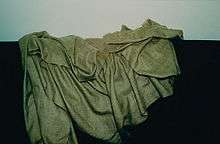Shahtoosh

Shahtoosh (also written shahtush, a Persian word meaning "king of fine wools") is the name given to a specific kind of shawl, which is woven with the down hair of the Tibetan antelope (chiru), by master craftsmen and women of Kashmir, Northern India. The Shahtoosh shawl is now a banned item with possession and sale being illegal in most countries for the Chiru is an endangered species under CITES. However, the weaving of Shahtoosh shawls continues in secret in Kashmir due to high demand by western buyers. The estimated market value of one Shahtoosh shawl in the western market is around $5000–6000.[1] Shahtoosh is the world's finest wool having the lowest micron count, followed by Vicuna and Pashmina.
Characteristics
These shawls were originally very few and could only be woven by master artisans to weave the delicate hair which measured between 7 and 10 microns. These factors made shahtoosh shawls very precious. Shahtoosh shawls are so fine that a large shawl can be passed through a wedding ring, leading to them also being known as 'ring shawls.'
Source of the fiber
The Tibetan antelope or Chiru lives in one of the harshest environments on earth, at an altitude of over 5,000 metres. Their special type of down fur, which is both very light and warm, allows them to survive in the freezing conditions of the plateau where they gather at one point of the year. They are migratory animals - moving down from Mongolia to Tibet - and traditionally followed closely by the nomads, who also make that journey every year. The nomads would hunt the antelope for all that it provided them - hide, meat, bones, horns and fur pelts - in short, everything that the nomads needed to sustain them through their journey.
Production
The incredible fineness and brittleness of Shahtoosh fibre makes it virtually impossible to handle - and this is where the master weavers of Kashmir play their role. With their expertise in hand processing Pashmina or Kashmiri Cashmere wool, they have the ability to weave shawls from Shahtoosh of the most exquisite quality.
Types of Shahtoosh Shawls
The type of Shahtoosh is determined by the quantum of Toosh or Tibetan Antelope down in the fabric. The measurement system used for determining it is called Dani in Kashmiri, with 1 Dani equal to 1/16 in terms of fibre composition. The typical types of Toosh are:
- Shurah Dani or 16 Dani: a 100% Toosh Shawl,
- Bah Dani or 12 Dani: a 75% Toosh and 25% Pashmina Shawl, and
- Aeth Dani or 8 Dani: a 50% Toosh and 50% Pashmina Shawl wherein the warp is generally of Toosh and the weft is Pashmina.
History
When the British (of British India) traveled to Kashmir in Summer, they realised the worth of Pashmina and shahtoosh shawls and introduced them to the world, which led to greater demand for these products. Subsequently, the antelope was hunted down specifically for its fur, and their numbers have dropped accordingly from nearly a million (estimated) at the turn of the 20th century to less than 75,000 today. The numbers continue to drop yearly. This led to the antelope now being listed as an endangered species and given the highest possible level of legal protection, whereby no commercial trade in shahtoosh is permitted.
The selling or owning of shahtoosh was made illegal in all countries that signed the Convention on International Trade in Endangered Species. Many countries, including the United States, China, Pakistan and India, are cracking down on those involved in the shahtoosh trade. Although shahtoosh is banned under the agreement, illegal hunting and selling of shahtoosh is still a serious problem in Tibet.
See also
- Himroo - Himroo fabric is made of both cotton and silk in the Deccan region of India
- Kekexili: Mountain Patrol - a film based on the Wild Yak Brigade of the 1990s that sought to limit poaching for Shatoosh
- Pashmina - type of fine cashmere wool
- Shahmina - type of shawls made from 13 micron fine Pashmina
References
External links
| Wikimedia Commons has media related to Shahtoosh. |
- US Fish and Wildlife Identification Guidelines for Shatoosh and Pashmina
- Endangered Species Handbook | Tibetan Antelope
- U.S. Proposes to List Tibetan Antelope as Endangered
- Washington Times | Kashmir rethinks shahtoosh ban
- Shahtoosh: Can the prized industry be revived again?, IANS New Delhi/Srinagar, April 10, 2012, India Today